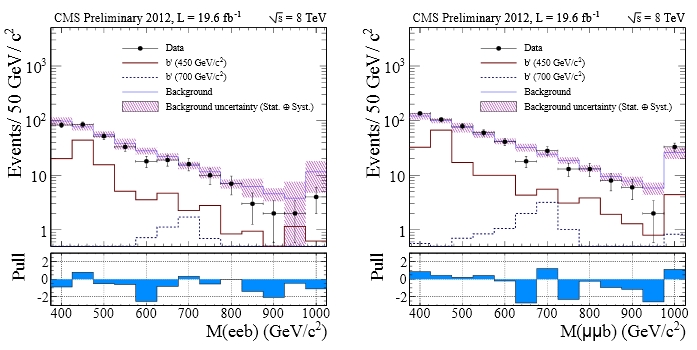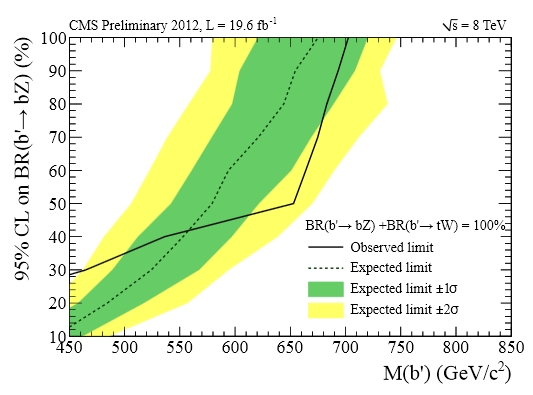Neutral currents, unlike charged currents (W emission) cannot change the flavour of a quark in the Standard Model. However, if we consider new quarks with vector-like properties (a way of saying that the quark couples symmetrically to vector bosons regardless of its helicity), that decay mode is possible, and may even be dominant as the mass of the heavy quark is large.
So far a heavy b' quark had been sought by CDF (268), CMS (550), and ATLAS (645-720), where the number in parenthesis indicates the lower limit on the mass of the quark set by the corresponding search, in GeV. The ATLAS numbers are two because they considered two possible schemes for the fourth generation of quarks, a singlet and doublet scenario.
I should now explain that in all these searches for heavy particles the way one sets a lower limit on the mass is by first determining an upper limit on the number of such particles produced in a given amount of collisions, and then comparing that experimental limit with the number calculated by theorists of particles that would have been produced as a function of the particle mass: since lower masses almost invariably imply higher production rates, the upper limit on the production rate becomes a lower limit on the mass. The reasoning is thus "if these things were lighter than x, there would be more than y of them in my data; but I know there are fewer than that (otherwise I would have detected a signal!!), so they must have mass M>x to exist".
These searches all assumed, for simplicity, a 100% branching fraction of the b' to bZ final states; of course if the branching fraction of the decay is smaller the limit on the production rate worsens, and hence also the mass becomes less constrained.
CMS sought for b'->bZ events in 2012 data (19.6 inverse femtobarns of 8-TeV collisions) by looking for reconstructed Z->ee and Z->μμ decays accompanied by a b-tagged hadronic jet (from the energetic b quark emitted in the decay). The combined mass of the bZ system can then be fit by a background model and a hypothetical contribution from the b' signal, as shown below (the signal is shown as a dashed histogram for a mass of 700 GeV).

On the left is the subset of events where the Z is observed to decay in electron-positron pairs, on the right the corresponding data for Z->μμ decays. The shaded bands indicate the total background prediction, and the lower insets in the graphs show the difference between data and background in units of the total uncertainty.
Since the b' quark is assumed to be produced in pairs, there are in principle two b' quarks in the final state. The search is however inclusive, in the sense that one single b' is sought. The other may decay to the same final state, or to tW pairs. CMS set very loose requirements on the additional objects in the final state, such that one does not need to assume a 100% branching fraction to bZ a priori. All that CMS assumes is that the sum of branching fractions to bZ and tW is unity.
The CMS lower mass limit at 95% confidence level, assuming a 100% FCNC branching fraction b'->bZ, is at 700 GeV. CMS also produced a mass limit as a function of the branching fraction. It is shown below: as you see, as the supposed branching fraction becomes small, the mass limit loosens considerably.

As usual, the full black curve indicates the observed limit, and the dashed one (with accompanying "brazil band") shows the expected one.



Comments